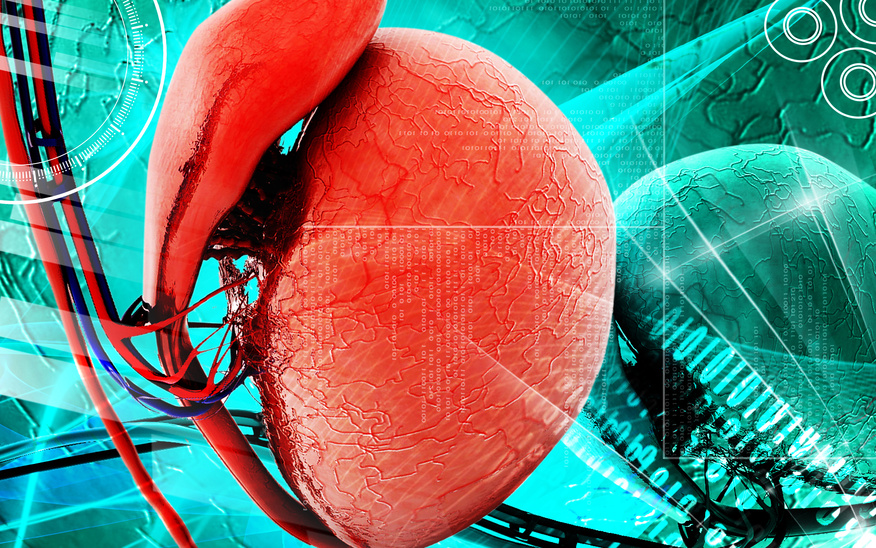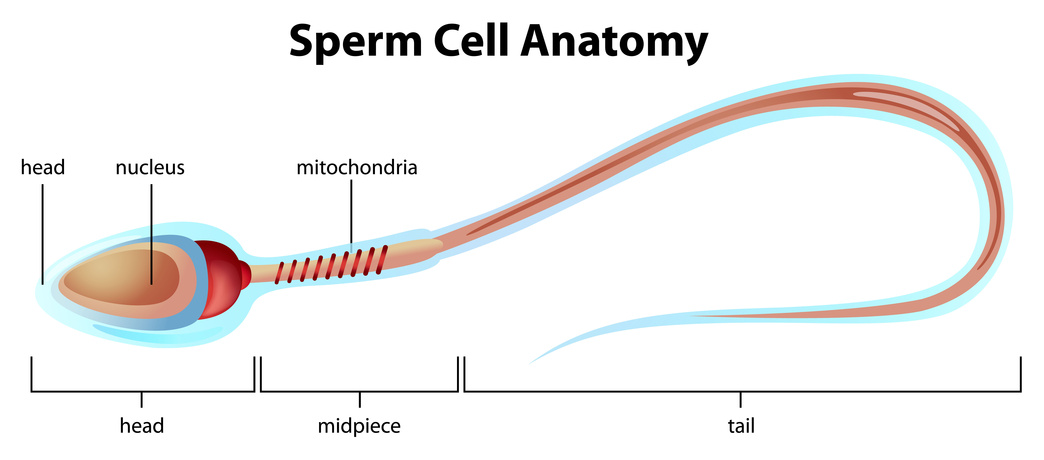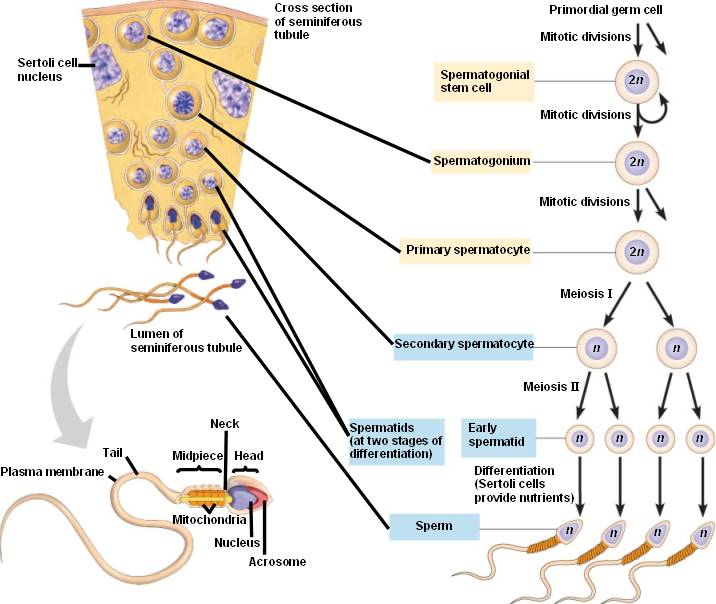
Sperm cells are the male gametes, the cell that fuses with another cell during fertilisation. The average man produces more than 1,000 sperm cells every single second and they need around nine to ten weeks for their full development and maturation. In contrast a woman has already got all of her egg cells present at the time of her birth.
Men have certain stem cells, which are capable of cell division and form new sperm cells throughout a man’s life.
The tiny sperm cells are highly specialised to fulfil their function, which is solely to fertilise an egg cell. Each sperm cell has a mobile tail, known as a flagellum, which means that the cell can swim through the uterus. The energy required for its movement is provided by the middle section of the sperm cells, which is equipped with lots of small ‘power stations’ called mitochondria.

www.amitamin.com/en/fertilsan-m New life deserves the best possible start!We provide the essential building blocks for this.
DNA transporter
All of the genetic information is found in the head of the sperm cell, where it is highly compressed to make sure that the sperm cell is small, light, and fast. Finally at the front of the head of the sperm cell is the acrosome, which contains special substances which can break through the protective covering of an egg cell. This is needed to allow the sperm cell to penetrate the egg cell, in order to fertilise it.
Spermatogenesis: From stem cell to sperm cell
The “factory” stem cells, known as spermatogonia, are formed in the testes of a man before birth. These original stem cells can multiply both before puberty and after reaching sexual maturity, so that they are continuously forming new cells to ensure a large supply of sperm cells.
After the onset of puberty, the spermatogonia now divide into two new immature sperm cells. Many of these multiply to form primary spermatozytes, which is the beginning of the process of spermatogenesis.
Cell division
Subsequently, a meiotic cell division occurs. The cell’s genetic information (DeoxyRibonucleic Acid which is known as DNA) is halved. All of the cells of the human body the chromosomes, which carry genetic information, hold two copies of the genetic information in 46 chromosomes, which are arranged into 23 pairs. The set of chromosomes in the egg cell and the sperm cell contain only one copy of each parent’s genetic information. These gametes therefore only contain 23 chromosomes.
How mother and father “merge”
Once sperm and egg have fused, two copies of the genetic information are present in 46 chromosomes. The cells created through the first meiotic division are known as secondary spermatocytes. At this stage, another division occurs which results in the formation of so-called spermatids. These spermatids in turn differentiate into mature sperm cells, known as spermatozoa. This process lasts for approximately 64 days, which is relatively long for mother nature.
To compensate for this long maturation process and ensure that plenty of sperm cells are available at any time, human testicles produce sperm cells at a rate of more than 1,000 sperm cells, every second!

The development of the male sexual organs
The two testicles of a man are separated by connective tissue into several hundred small lobules called germinal or seminiferous epithelium. In the seminiferous epithelium, the so-called Sertoli cells can be found, along with the maturing sperm in the seminiferous tubules. The purpose of the Sertoli cells is to support and nourish the germ cells, coordinate their development and protect them from being attacked by a man’s own immune system.
The last point is important. Gametes are seen as being foreign to the body with their single set of chromosomes. They would be normally be attacked and eliminated upon coming into contact with the immune system. A semen analysis therefore checks for white blood cells to ensure there is no autoimmune reaction going on against a man’s own gametes. This can be a cause of male factor infertility.
Ready for ejaculation
Each testis is connected to its overlying epididymis by a thick convoluted canal. The sperm mature in the epididymis further on, and are stored here until they are released outside the body during ejaculation along with various fluids from the penis. For example, the secretion from the prostate ensures that the sperm cells can actively move.
The seminal vesicles provide the sperm cells with a fluid which supplies them with a sufficient amount of energy. At the same time the seminal fluid also has a high pH value. This neutralises the acidic environment of the vagina allowing the sperm to survive in it.
Important factors in optimal sperm development
Here are the most important tips for optimal sperm development. The difference between following this advice and ignoring it amounts to a factor of 10 or more. By following this advice you can therefore expect your sperm to have 10 times better quality and mobility!
Factor 1:
The temperature inside the scrotum should never be greater than 36°C. Regular sessions in the sauna, heated seats in the car or clothing which is too tight and presses the scrotum against a man’s body can lead to temporary disruption of sperm production[1]”Zhang XZ, Liu JH, Sheng HQ, Wu HJ, Wu Y, Yao KS, Lu JC, Zhang FB. Seasonal variation in semen quality in China. Andrology. 2013; 1(4): 639-43″
Factor 2:
The body needs a variety of vitamins, amino acids and other nutrients for the production of sperm. Missing a vital element can result in insufficient development. Therefore eat plenty of raw fruit and vegetables, or take a nutritional supplement containing a range of vitamins. We have presented various male fertility products here.
Factor 3:
The most important raw material for spermatogenesis is L-arginine. This important amino acid is the essential component of spermatin.
Without L-arginine, it is impossible for healthy sperm development to take place[2]”Srivastava S, Desai P, Coutinho E, Govil G. Mechanism of action of L-arginine on the vitality of spermatozoa is primarily through increased biosynthesis of nitric oxide. Biol Reprod. 2006; … Continue reading. A study conducted at the University of Louisiana showed that by taking a 5,000mg dose of L-arginine per day, the proportion of healthy and mobile sperm quadrupled.
Highly dosed L-arginine products are often marketed as treatments for erectile dysfunction[3]”Chen J, Wollman Y, Chernichovsky T, Iaina A, Sofer M, Matzkin H. Effect of oral administraion of high-dose nitric oxide donor L-arginine in men with organic erectile dysfunction: results of a … Continue reading, because they promote blood circulation in all blood vessels including in the spongy tissue of the penis. More information on L-arginine can be found here.
Other biological limitations
The messenger substances testosterone, FSH (follicle stimulating hormone) and LH (luteinising hormone) must interact optimally in order for correct sperm development to occur. Sometimes infertility can be caused by a hormone deficiency.
The Sertoli cells form a natural barrier from the blood. Through an injury or inflammation of the seminal tract, this barrier between the blood and the testes can become compromised, so that the immune system reacts with and attacks a man’s own sperm cells.
Since the process of sperm development required more than two months, an improvement in sperm quality through a change in lifestyle factors is only noticeable after this time. Therefore plan to start your fertility supplements and healthy diet at least three months in advance and continue until a pregnancy has been achieved.


Dr. Kooner is Deputy Director of The Advanced Fertility Center of Chicago and has been a Specialist in Fertility Treatment since 1999.
As well as the areas that the clinic specialises in general, he is particularly interested in managing oocyte donation, female same-sex couples, single women having sperm donation and those considering egg freezing.
Dr. Kooner regularly speaks at fertility meetings. He has published in national journals and constantly contributes to the fertility research and publications from Advanced Fertility Center of Chicago.
References
| ↑1 | ”Zhang XZ, Liu JH, Sheng HQ, Wu HJ, Wu Y, Yao KS, Lu JC, Zhang FB. Seasonal variation in semen quality in China. Andrology. 2013; 1(4): 639-43″ |
|---|---|
| ↑2 | ”Srivastava S, Desai P, Coutinho E, Govil G. Mechanism of action of L-arginine on the vitality of spermatozoa is primarily through increased biosynthesis of nitric oxide. Biol Reprod. 2006; 74(5): 954-8″ |
| ↑3 | ”Chen J, Wollman Y, Chernichovsky T, Iaina A, Sofer M, Matzkin H. Effect of oral administraion of high-dose nitric oxide donor L-arginine in men with organic erectile dysfunction: results of a double-blind, randomised, placebo-controlled study. BJU Int. 1999; 83(3): 269-73″ |




